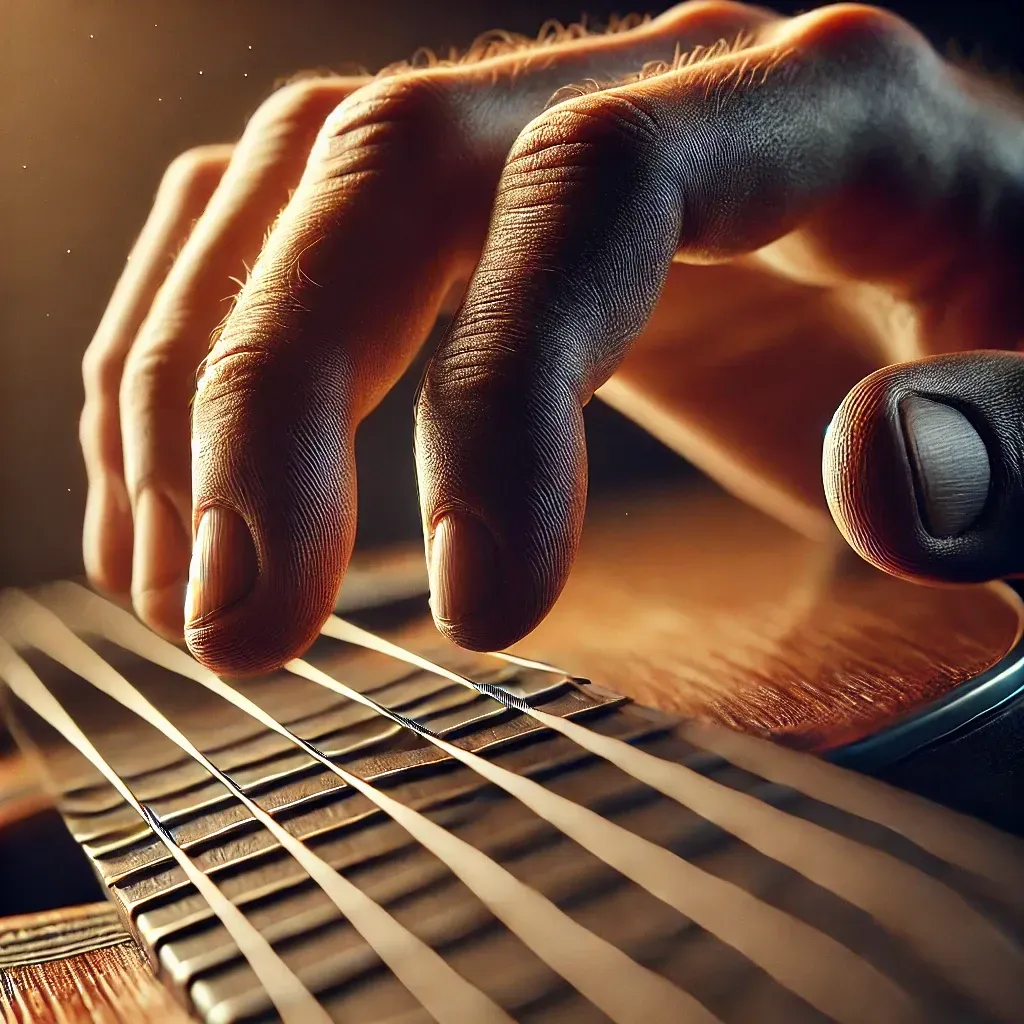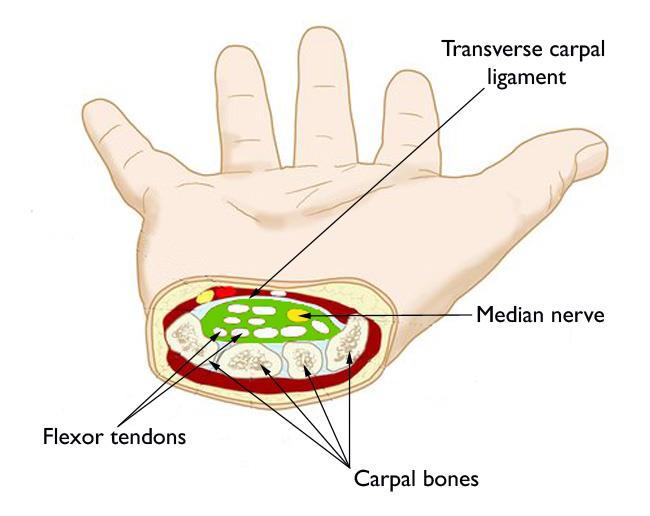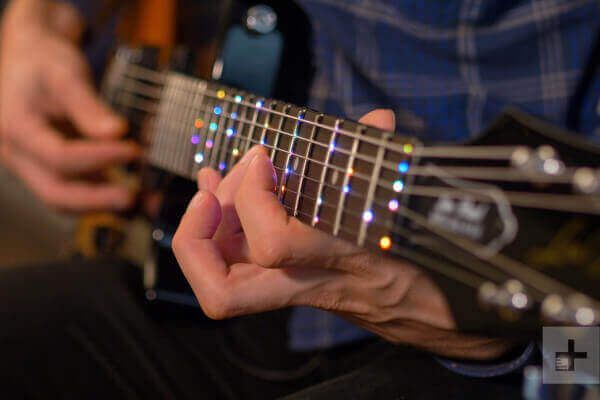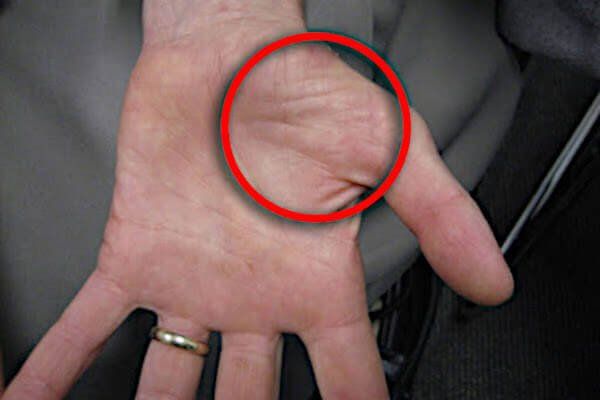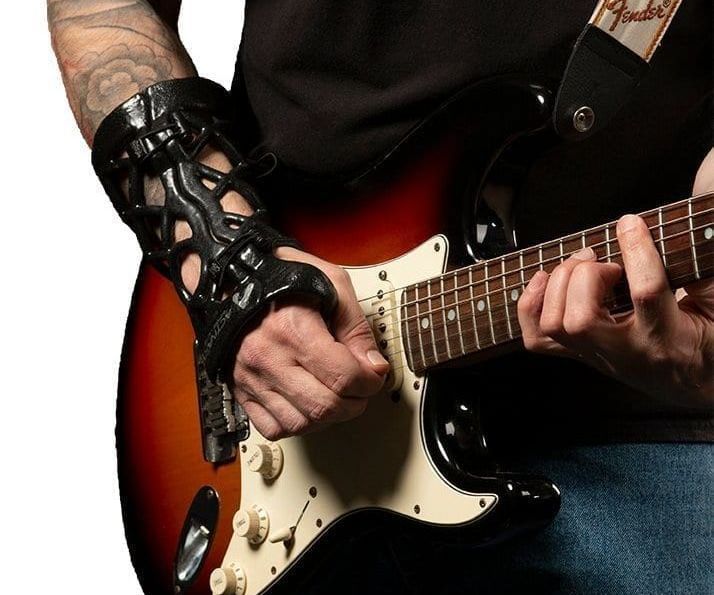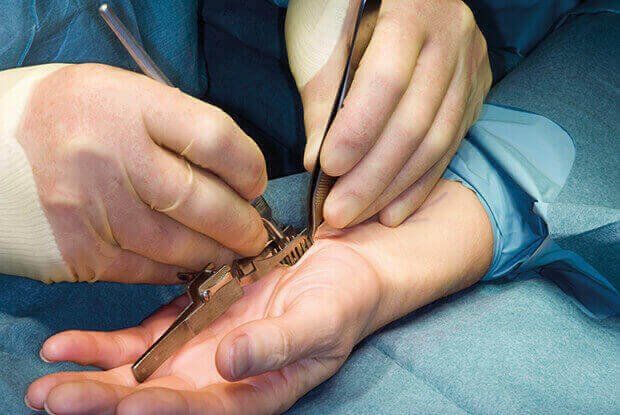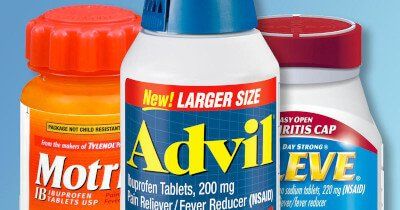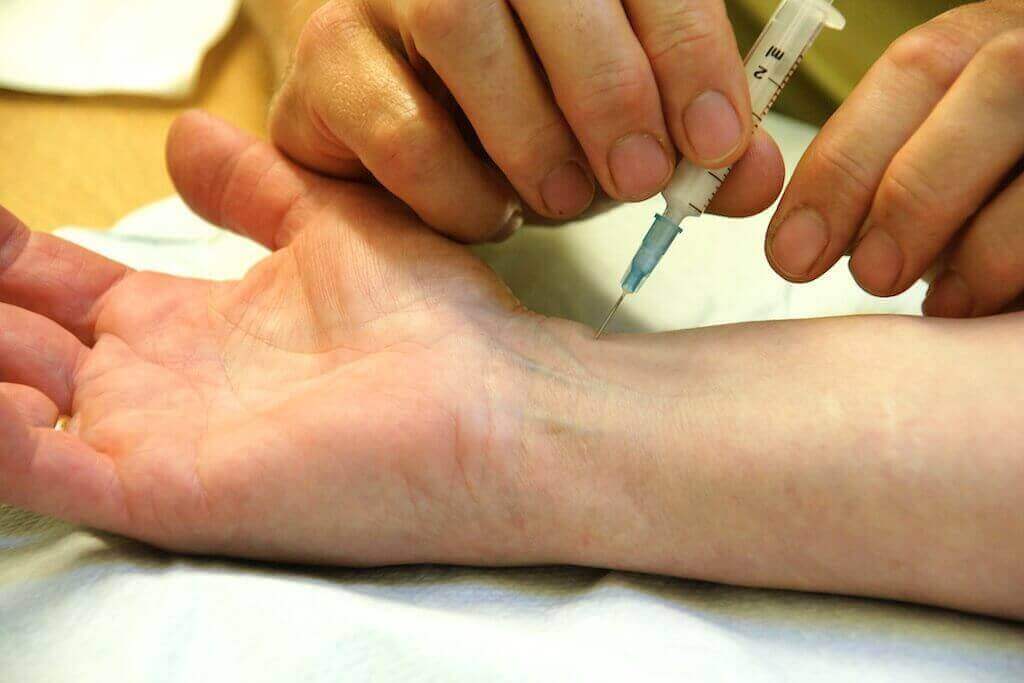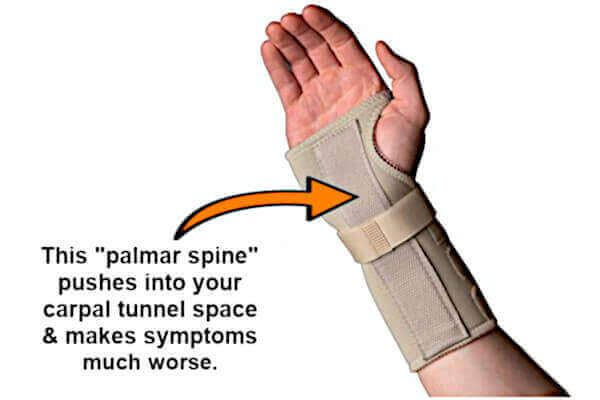Carpal Tunnel From Guitar Playing
Getting carpal tunnel from guitar playing is extremely common. In fact, a day doesn’t go by when a guitarist doesn’t ask us what to do about their numb or painful fingers and hand. Here's what’s going on.
Table of Contents
- The problem is
almost always carpal tunnel syndrome
- How carpal tunnel happens
- The reason you get carpal tunnel from guitar playing
- Fretting hand vs picking hand
- The fretting hand
- The picking hand
- The ultimate carpal tunnel maker is the guitar!
- As carpal tunnel symptoms progress
- Mild stage carpal tunnel
- Moderate stage carpal tunnel
- Severe stage carpal tunnel
- How common is carpal tunnel from guitar playing?
- What can be done?
- Carpal tunnel release surgery
- Non-surgical treatments
- Drugs
- NSAID drugs
- Steroid shots
- Stretching exercises
- Night bracing
- Brace only at night
- Never brace during the daytime
- Myofascial release massage
- Summary
The problem is
almost always carpal tunnel syndrome
Playing the guitar requires rapid movement of all fingers for an extended period of time. This produces one of the most common “overuse” musculoskeletal disorders today, called
carpal tunnel syndrome.
Anybody who uses their hand for rapid and repetitive activities is at high risk for getting this painful condition. In fact, there are several,
high-risk (i.e., harmful) hand and finger motions notoriously associated with carpal tunnel syndrome. So it's no wonder why getting carpal tunnel from guitar playing is so common.
This disorder isn't something exclusive to musicians. Other professionals are also at high risk for getting carpal tunnel syndrome because they perform similar, harmful hand activities. These professions are as diverse as
graphic artists, golfers,
video gamers,
hairdressers, carpenters,
fine artists, sonographers,
transcriptionists, typists, and
dental hygienists, just to name a few.
How carpal tunnel syndrome happens
At its core, carpal tunnel syndrome is
a result of overworked or stressed
flexor tendons. These tendons run from your forearm to your fingertips. They're responsible for curling your fingers (creating a gripping or pinching action).
When tendons are stressed, their coverings (sheaths) inflame and swell with
fluid. Normally, that swelling isn’t such a problem anywhere else on the forearm. But if swelling and fluid builds up inside the wrist joint, things gets seriously bad.
Inside the wrist joint the flexor tendons travel through a passageway called the
carpal tunnel
(hence the condition’s name). As shown in the picture above, they’re accompanied through the passageway by the median nerve.
The
median nerve is responsible for activating finger movements and also carries sensory information from the fingers all the way to the brain. In other words, it’s the
main motor and sensory highway
for the hand and fingers.
With stress, flexor tendons inflame and swell (expand) with fluid. That means they push against the adjacent median nerve. With no extra room, the median nerve gets squeezed and compressed. This results in a “compression injury” to the nerve, causing
neuropathy or nerve damage. This neuropathy produces all the unpleasant symptoms of carpal tunnel syndrome.
The reason you get carpal tunnel from guitar playing
To summarize, the reason you feel
symptoms of carpal tunnel from guitar playing is the result of the median nerve’s compression. The compression produces neuropathy. This results
in motor problems like weakness or limited hand movement. It also results in a variety of sensory problems, like pain, numbness, and tingling.
Actually, the most common neuropathy sensations caused by carpal tunnel syndrome are usually limited to the palm and wrist area. They usually include one or more fingers (not the pinky). The major sensations are:
Fretting hand vs picking hand
Symptoms of carpal tunnel can happen on either hand, and for different reasons. But when it comes to guitar playing, we can boil the reasons down to particular hand and finger motions.
The fretting hand
In the
fretting hand, holding the guitar neck is particularly stressful to the hand’s anatomy. Curling and holding your thumb and fingers forces joints into awkward, stressed positions for prolonged periods of time.
The result is that tendons stay twisted and contracted more than normal.
This also forces the median nerve backward, pressing it against the wall of the carpal tunnel passageway.
Usually, merely twisting and bending your hand isn’t harmful. But if you twist it in that particular position, hold it, and then produce rapid finger movements, you’ve created the perfect recipe for carpal tunnel syndrome.
The picking hand
In the
picking/plucking hand, the fingers are rapidly moving (and sometimes pinching). While the wrist joint may be in a natural position, the fingers are in a constant, contracted or flexed position.
But it's the rapid wrist and finger motions that produce the most stress on tendons. Given the extreme picking speeds achieved by some guitarists, all of this creates enormous strains on tissues designed for only a fraction of that activity.
The ultimate carpal tunnel maker is the guitar!
Knowing the above facts, there's no mystery about how you acquire carpal tunnel from guitar playing. Extreme forces on the tendons produce stresses and strains that are, well, unnatural. You can see why I tell my guitar playing patients...
"If I designed the perfect device to CAUSE carpal tunnel, it would be a guitar!" -Dr. Z
As carpal tunnel symptoms progress
Carpal tunnel syndrome progresses through 3 general stages:
- Mild stage
- Moderate stage
- Severe stage
The amount of time it takes to go from the mild to severe stage varies from person to person. It especially varies according to how many hours per day you play guitar. Generally speaking, the more hours spent on the guitar, the faster the condition’s progression.
Without treatment, the majority of patients go from the mild stage to
severe stage
within 9 months.
Almost 80% of carpal tunnel sufferers will eventually see symptoms on the opposite hand as well. This is called
bilateral carpal tunnel syndrome. Symptoms usually appear on the other hand within 6 months from when they first appeared on the initial hand.
Mild stage carpal tunnel
Symptoms of carpal tunnel from guitar playing begin to show up in the mild stage.
Unfortunately, this is when patients should do something about it, but they usually don't.
When caught and treated in this stage, mild symptoms will resolve 50% of the time with simple rest and some night bracing. But in cases where mild symptoms are ignored, they will
almost certainly worsen.
During the
mild stage, pain,
numbness, and tingling are only just beginning. They creep up very slowly. In fact, many people don’t even notice a problem unless they’re thinking about it.
Also in the beginning, there's usually a "stress delay" when the symptoms show up. In other words, some people might feel the symptoms immediately after playing. Other times symptoms show up a few hours after playing, perhaps while holding a steering wheel or a phone.
In almost every case, mile (initial) symptoms will occur at night while you're trying to sleep. Many say they have to wake up and shake out a numb hand or rub out painful fingers.
Moderate stage carpal tunnel
When symptoms go from mild to moderate, the problems usually escalate fast. It’s also the stage when most people seek professional help. In the moderate stage:
- Numbness is ever-present, and your hand or fingers may feel like balloons. Hand clumsiness is an everyday problem.
- Pain gets more severe, especially in the thumb, and at night.
- Sometimes
shooting electric shocks occur when trying to grasp objects.
- Usually the hand and fingers lose 20-50% of their strength. Even opening a jar becomes impossible.
- Loss of finger speed and dexterity is a problem in everyday use, not just guitar playing.
- All of the above also coincides with losing the sensation of fine touch in your fingertips.
When these difficulties manifest, everyday life changes for the majority of carpal tunnel sufferers. If left untreated, most guitarists put their instruments down for good during the moderate stage of carpal tunnel syndrome.
Severe stage carpal tunnel
In the
severe stage numbness or pain is constant, with no respite during the day or night. And it's almost intolerable. It can be so bad that patients often tell me,
“I want to cut my hand off.”
Some describe the numbness as “crushing” that’s ever-present and relentless, at night and during the daytime. If the main symptom is pain, people describe it as "cruel" or "punishing" and it's always relentless.
Eventually patients lose the feelings of hot and cold sensations in their fingers and hand. Also, the muscular bump at the base of the thumb (the thenar eminence) noticeably flattens out, and the skin over the muscles wrinkle. That’s because the thumb muscle has degenerated. This begins the final, irreversible stage of carpal tunnel syndrome called the "end stage".
How common is carpal tunnel from guitar playing?
Guitar players are at very high risk for this condition. In fact, most doctors will tell you that a high proportion of their carpal tunnel patients are guitar players (piano players are a close second).
Unfortunately, nobody has the exact statistic because good clinical surveys are still lacking.
But overall musculoskeletal disorders occur in 26-93% of musicians.(1) That’s very high by any measure.
In one study of guitar players (2), the average rate of all "overuse disorders" (including carpal tunnel syndrome) was 75%. That was further broken down as occurring in:
- 62.5% of classical guitarists
- 87.5% of flamenco guitarists
Moreover, among the guitarists affected by overuse disorders, the ability to play guitar declined dramatically in:
- 50.0% of classical guitarists
- 82.1% of flamenco guitarists
By any standard, these statistics are astonishing. And since carpal tunnel syndrome is the
predominant overuse disorder,
we can extrapolate the following from the data: carpal tunnel syndrome from guitar playing is the primary cause of most of these hand problems.
From experience, I'm very familiar with this issue. So when guitar players ask me what to do, I always advise the same thing...
- If you treat early, you’ll probability beat it.
- If you wait, it will almost certainly worsen.
- And that’s when it’s hardest to treat.
What can be done?
Getting carpal tunnel from guitar playing is a major problem among musicians. Unfortunately, most guitarists don't take the mild warning signs very seriously, but only take action when the moderate stage hits.
At first, thinking their hands are just overworked, most people try inexpensive, half-hearted measures. They might soak their hands in ice water. Or they might buy a cheap wrist splint from Walgreens, Walmart, or CVS for $16.00.
But it's unfortunate that even with the most sincere intentions, most people don’t realize how serious carpal tunnel syndrome actually is. They don't understand that these insignificant measures are wasting valuable time as the disorder progresses towards the severe stage.
Simple treatments like rest and night bracing will normally work well if symptoms are caught in the
mild stage. But when I get patients – usually in the moderate or severe stages - simple bracing alone is too little, too late. The easy remedies are just not enough anymore.
If you have moderate or severe carpal tunnel (from guitar playing or anything else) you have two options to treat it:
- Carpal tunnel release surgery
- Non-surgical remedies
The success of either option is proportional to how long you let symptoms go, and how severe they are. The
American Academy of Orthopedic Surgeons (those who regulate hand surgery) and the
National Institutes of Health both recommend that
surgery should be your last and final option, when all non-surgical attempts failed.
Carpal tunnel release surgery
Surgical treatment involves a procedure called
carpal tunnel release. After back surgery, it’s the most common surgical procedure performed in the United States today. It can be performed in one of two ways:
- In
open carpal tunnel release surgery the surgeon makes a 2-3 inch long incision on the palm and cuts the transverse carpal ligament over the wrist joint. The operation is performed using general or local anesthesia and on an outpatient basis.
- In
endoscopic carpal tunnel release surgery the surgeon makes one or two smaller incisions in the hand. Then the ligament is cut via the tiny hole(s) in the palm. The operation is usually performed with local anesthesia and on an outpatient basis.
With both ways of doing the surgery, the end result is the same. The carpal ligament is cut, thereby giving more “breathing room” to the median nerve so it's no longer crushed. It also allows excess fluid pressure drain away. The resultant release of pressure on the nerve “decompresses” it, thereby relieving the neuropathy.
After surgery most patients require several months of hand physical therapy and rehabilitation to restore strength and function. Guitar players who had surgery usually must make some type of playing adjustment. About
50% of patients never recover full hand function after surgery.
Non-surgical treatments
Most musicians who acquire carpal tunnel from guitar playing seek
non-surgical remedies first. Understandably, few of them feel comfortable with having their hand cut open.
Happily, for most patients in the moderate and even severe stages, non-surgical treatment of carpal tunnel syndrome is effective and lasting. Usually two or more of these remedies (listed below) must be used concurrently. The most often used non-surgical treatments are categorized as:
- Drugs
- Night bracing
- Stretching exercises
- Myofascial massage
Again, each treatment
alone
can work to relieve
mild
stage symptoms. But for
moderate to severe
stage symptoms, it’s best to use a combination of the above treatments concurrently.
Drugs
NSAID drugs
Drug therapy for carpal tunnel syndrome is by far the most widely used. It focuses on reducing pain and swelling. Over-the-counter non-steroidal anti-inflammatory drugs (NSAIDs) are the most common. These include Advil, Aleve, Motrin, and Tylenol. They’re particularly effective in the
mild
stage of carpal tunnel syndrome.
Be mindful that simply relieving pain with drugs doesn’t solve the problem of why you have carpal tunnel syndrome to begin with. In other words, drugs don't stop carpal tunnel at the source, but
merely mask the pain .
Also, these drugs don't help drain excess fluid from the wrist joint. That fluid build-up causes pressure on the median nerve, and it must be drained.
Therefore, when symptoms are beyond mild (i.e., they have elevated to the moderate or severe stage), using NSAID drugs is almost pointless.
Steroid shots
Corticosteroids (steroids) are commonly used to reduce swelling by injecting them directly into the carpal tunnel passageway. This temporarily relieves pressure on the median nerve by reducing local inflammation.
The steroid shots provide temporary pain relief in about
45% of sufferers. However, like NSAIDs, they only relieve pain for a short while (3-5 months). They don’t drain excess fluid nor do they attack the root cause of why you have carpal tunnel in the first place.
Steroid shots are helpful with moderate (and is some cases, severe) symptoms. However, you
cannot have more than a few steroid shots per lifetime. That’s because of the risks and dangers associated with too many steroid shots.
Stretching exercises
For mild or moderate stage carpal tunnel syndrome, stretching exercises, when maintained, can provide long-term relief. That’s because they force tendons to glide, lubricate, and drain excess fluid.
However, these exercises
alone
are usually not sufficient for moderate or severe symptoms. Additional therapies in combination with the stretching exercises, like night bracing and massage (see below) help the most.
There are literally hundreds of videos and self-help tutorials about which exercises are best. In my experience,
4 core stretching exercises are vital; most others are not nearly as important. The 4 core exercises focus on stretching the flexor tendons inside the carpal tunnel passageway all the way to the forearm muscles.
These stretches must be performed several times a day. Again, they’re best to use
in combination with night bracing and massage to effectively alleviate symptoms.
Night bracing
Brace only at night
If you have symptoms of carpal tunnel from guitar playing, then bracing your hand and wrist while you sleep is
essential.
When we sleep, we unconsciously bend our hand backward (in extension). Holding that position for long periods of time increases pressure inside the carpal tunnel space, further compressing the median nerve.
But a night brace will keep the hand in the “neutral position” - which is essential y straight. That position maintains the carpal tunnel passageway in the widest anatomical shape. And that shape gives the median nerve a bit more “breathing room”.
When
choosing a night brace, never use one that has a metal spine on the palmar surface (see picture). If it has one, it’s not a
certified carpal tunnel brace.
A certified carpal tunnel brace is designed to specifically treat carpal tunnel syndrome. There currently are
9 companies manufacturing such braces (listed at this link).
And there are plenty of braces to stay away from (at the same link).
A metal spine will push into your wrist joint if you bend your hand backward. That will multiply the pressure inside the carpal tunnel, further damaging the median nerve. You may be like many patients who told me they slept with such braces, only to wake up with worse symptoms.
Now you know why.
Never brace during the daytime
Most importantly,
never wear a wrist brace during the day while your hand is working or playing. There are two reasons for this:
- First, wearing a wrist brace will force your hand to fight it subconsciously. This makes the situation worse. It’s like doing numerous mini isometric exercises, which will further stress your tendons.
- Second, the only way the body can pump away excess fluid from a joint is by
joint movement. Restricting that movement during the day will hamper fluid drainage. The result is more fluid buildup and more pressure on the median nerve.
Myofascial release massage
Perhaps the strongest remedy for relieving carpal tunnel symptoms is myofascial release massage. The technique produces 3 crucial results which are necessary for healing at any stage of carpal tunnel syndrome. This therapy:
- Breaks up painful, inflammatory
adhesions
and restrictions.
- Drains excess fluid around the median nerve.
- Encourages blood flow, restoring the injured nerve and damaged tendons.
Myofascial release massage physically stretches and forces the flexor tendons in multiple directions simultaneously. Essentially, it “kneads” the skin and underlying tissues.
There are many videos and articles about
performing myofascial release massage. But the basics are as follows: imagine kneading a bundle of sticky ropes as they bend and push against each other.
With enough kneading, eventually they un-stick.
The same happens with tendons. The “release” means that adhesions (also called “restrictions”) that make tendons sticky are broken apart.
- The adhesions cause tendons to inflame & expand, ultimately crushing the median nerve.
- This massage loosens & breaks up the adhesions.
- Therefore, this massage is crucial to alleviate carpal tunnel syndrome.
Myofascial release massage therapy is effective even in the severe stage of carpal tunnel syndrome.
However, it must applied twice daily for at least one month.
Crucially, you cannot perform a good myofascial release massage on yourself. That’s because you need two hands (actually, two thumbs) to effectively knead the tissues below the skin. It also requires a bit of skill, and many people simply do not have the time to learn it in order to help treat their partner.
Massage therapists, chiropractors, and physical therapists are skilled in this technique. It’s usually a huge part of each professional’s practice. But daily visits to the therapist are the big downside to myofascial release massage therapy.
While it’s highly effective (for even severe stage carpal tunnel syndrome) it must be performed twice daily for at least a month. Visiting a therapist that often can be very expensive.
However, the CarpalRx does all of this automatically - and at home.
Summary
Getting carpal tunnel from guitar playing is not unusual. The reason is that the guitar playing demands stressful finger and hand motions of both hands, and for prolonged periods of time. There are good nonsurgical remedies for carpal tunnel syndrome, especially if you catch the symptoms early. Therefore, if you have carpal tunnel signs like hand or finger pain, numbness, tingling, and burning then seek treatment now. Very effective nonsurgical treatments include rest, night bracing, stretching exercises, and myofascial release massage. These can prevent your condition from progressing to the moderate or severe stages.
Sources
About


